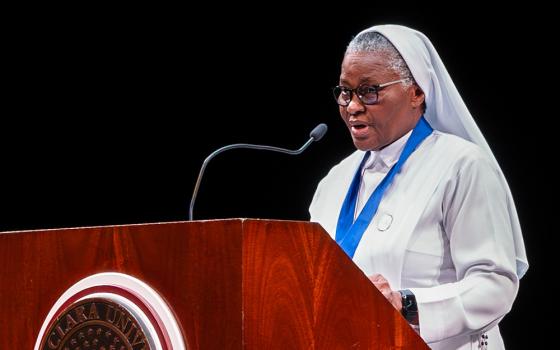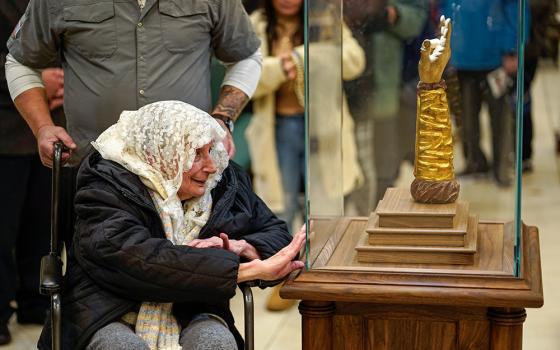The Wanderers by Henry A. Garon. Orbis (Maryknoll, N.Y., 2009). 151 pp., $16.
Read together, the books written by Susan R. Holman and Deacon Henry A. Garon and edited by Joseph A. Heim provide a sort of a miniseries on Christian perspectives of homelessness and poverty around the world.
In The Wanderers, Garon has written a refreshingly realistic book about ministering to the homeless of New Orleans. A Catholic deacon, father and husband, he provides short stories about the street people he has met and the experiences he has had while volunteering at Ozanam Inn. The inn is a homeless shelter located near the heart of New Orleans' business section and owned by the Society of St. Vincent de Paul.
The stories are compelling, well-written and certainly not fluff-filled memories of changing lives and the joy that ministering brings. Rather, his stories are grimy, sometime sad and always a realistic description of the human condition on the street.
His characters symbolize drug and alcohol abuse, depression and madness. His stories often end without a sense of closure, as Garon never sees the street people again to know if they succeeded in quitting drinking, stayed out of jail, reconnected with family or found a steady job.
His book covers his 28-year service to the homeless, which includes his work in the aftermath of Hurricane Katrina. One particular story stands out amid the rest. After the hurricane, when the inn was back up and running, a man told Garon that while he was in line outside the inn, a tour bus pulled up and its passengers started taking pictures of the men "like they were animals" at the zoo. This forced him to remember that at one time he also had felt disdain for these men. This is just one of many stories that forced him to reflect about his life volunteering at the inn.
 What They Taught Us, edited by Joseph A. Heim. Orbis (Maryknoll, N.Y., 2009). 126 pp., $15.
What They Taught Us, edited by Joseph A. Heim. Orbis (Maryknoll, N.Y., 2009). 126 pp., $15.
Within this theme of self-reflection, Heim's book, What They Taught Us, is a collection of stories shared by Maryknoll missionaries about lessons they learned from the poor. The stories take place in Guatemala, Venezuela, Bangladesh, Philippines, Tanzania and even Pennsylvania, to name a few places.
The lessons covered several topics, including interfaith work. For example, Maryknoll Fr. Douglas Venne wrote about his desire to pray more when he realized that the Muslim community in Bangladesh was praying five times a day to the same God. Their prayerfulness, which at first Venne considered an annoyance and disturbance, became his call to prayer.
The book also includes great lessons of the wealth of generosity, happiness and family in the face of poverty; one such story highlights refugee women in a Honduran camp who gathered corn to feed the starving children in another refugee camp despite their limited food supply.
The most poignant story is that of "the gentleman," a dirty, smelly homeless man in Tokyo who survived by collecting and selling scrap cardboard. The gentleman spent his last days caring for another man on the street, feeding him and sharing his meager living with him. The gentleman's generosity eventually led to his own death. Maryknoll Fr. John Grimm told this story, describing the gentleman as being "without a doubt a saint."
The stories and their lessons are quite beautiful, and a reminder not only of the wonderful work the church does abroad, but how the people the church serves are wonderful gifts made in the image of God.
 God Knows There's Need by Susan R. Holman. Oxford University Press (New York, 2009). 206 pp., $29.95.
God Knows There's Need by Susan R. Holman. Oxford University Press (New York, 2009). 206 pp., $29.95.
In contrast to Heim's and Garon's books, Holman's God Knows There's Need is not an easy read. Nor is it anecdotal. Instead, Holman writes like the Harvard academic she is, for, presumably, Harvard-type academics. And so, one must be in an academic mood to enjoy -- and understand -- her book. This is not to totally knock the book, because it has its moments. But the moments would be greater and far more frequent with a little bit more color and perhaps an accompanying professor to lead a discussion on her main points.
Holman's book explores the subject of poverty throughout time through the lenses of noteworthy Christians, such as Sts. Basil and Gregory. Importantly, her book reminds readers that poverty is a timeless issue, and Holman points this out via her exploration of ancient Christian responses to poverty.
Because the topic is so scholarly and specific, Holman's book would be great for a reader -- or researcher -- interested in dissecting poverty and need.
- - -
Lordan is a former assistant international editor of Catholic News Service and contributor to Catholic Radio Weekly.


